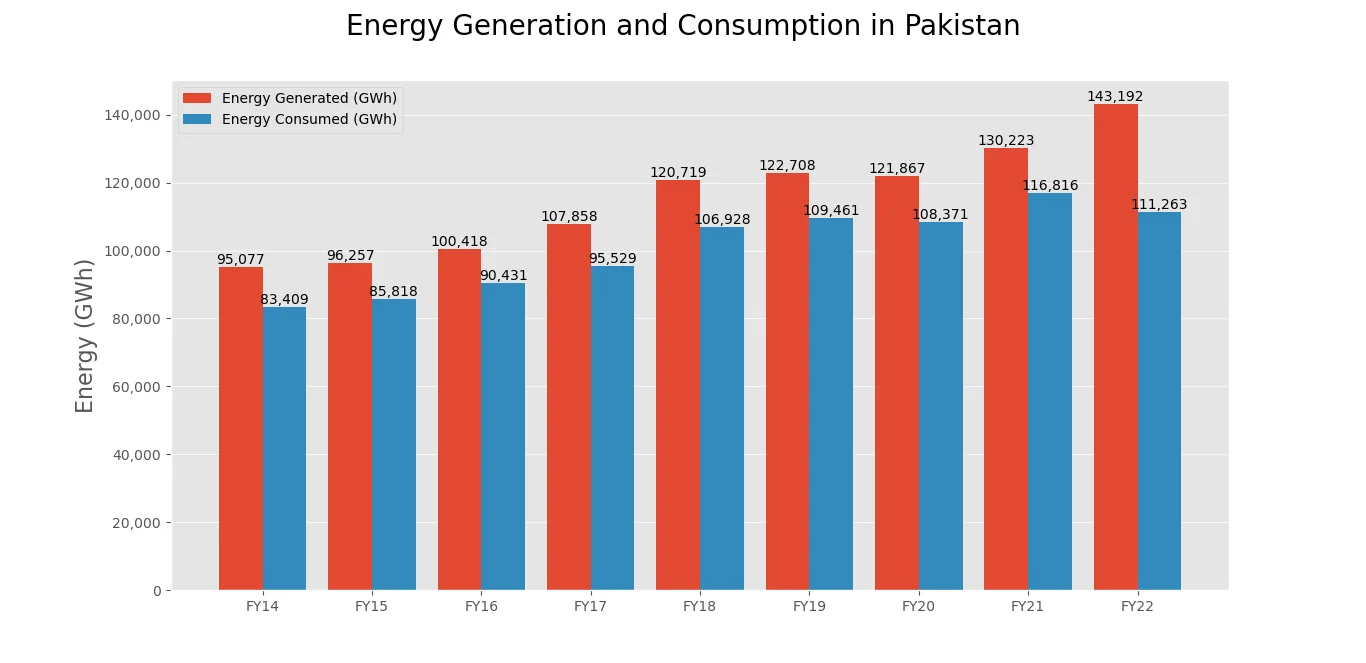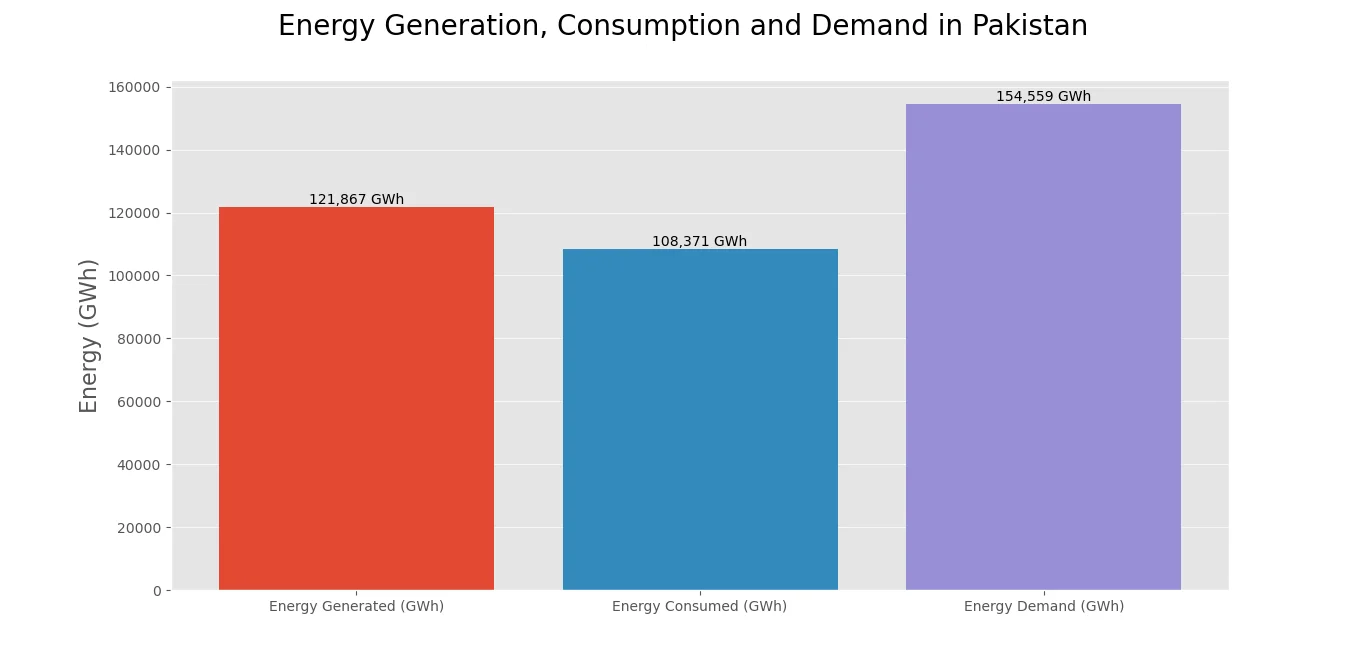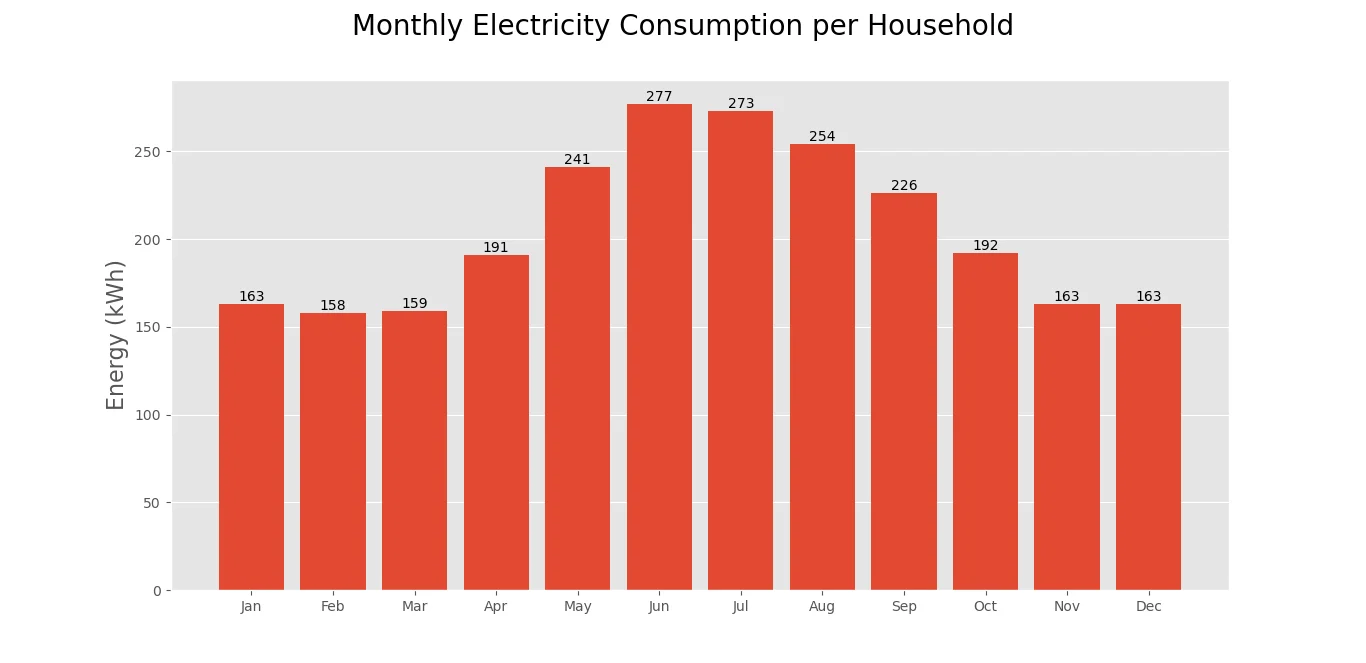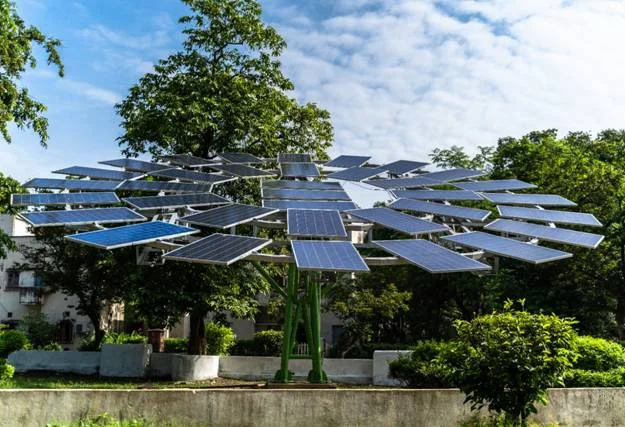“With heatwave-like conditions across the country, the prolonged power outages have added to the citizens' misery as the overall energy shortfall has surpassed 8,500 megawatts, sources told Geo News Sunday. The sources familiar with the matter said the country's total energy requirement stands at 28,500 megawatts, while it was producing around 20,000 megawatts.”
The News - June 25, 2023
What do these numbers mean? The goal of this article is not to provide a solution to the energy crisis, but for us to understand the concept of energy from a scientific standpoint so we can better comprehend the magnitude of the crisis. It is important to first understand how much energy Pakistan needs each year. Here is a plot of electricity generation in Pakistan from 2014 to 2023:

In FY2023, Pakistan generated around 130,000 GWh (Giga-Watt-hours) of electricity. This is equal to 130,000,000,000,000 Wh (Watt-hours). This seems like a lot of energy, so let’s put it in perspective. An average household in Pakistan uses 2,500 kWh (kilo-Watt-hours) of energy. This is enough energy for the annual consumption of around 50 million households. While overall the trend is increasing year on year, there are still some fluctuations between years as seen from the plot above.
The next question to address is: how much electricity do we actually need? The plot above shows only the amount of energy generated, not what we require. Additionally, not all energy generated ends up being used by the consumers. There are multiple reasons for this. Firstly, and most importantly, there are transmission losses, which are energy losses due to transmission over long distances. Secondly, it is difficult to match up the demand and supply of electricity perfectly (this is the purpose of the grid), so there are some losses from the inefficiency here as well. There are other factors as well such as theft, accidents, natural disasters causing damage, etc. The plot below shows the disparity between electricity generated and consumed over the last 9 years:

As we can see, roughly 10-20% of the generated energy is lost, and the remainder is consumed. So, to meet demand, we would need to produce at least this much extra energy to account for losses.
Now let’s take a look at the actual demand for energy. This number can only be estimated, because we do not produce enough energy to see how much consumers would use. If we had an excess supply of electricity, we would know the actual consumer demand for it. Below is a plot showing a case study for the financial year 2020:

The demand for energy in 2020 was 154,559 GigaWatt-hours (GWh). However, we were only able to generate 121,867 GWh this year, or 78% of the required energy. This leads to an energy shortage of 22%.
As stated previously, the average household in Pakistan uses about 2500 kWh in one year. So, the shortage of 33,000 GWh is equal to what around 12 million average households would need in a year. This is why we have “load shedding”, because we do not have enough energy to meet all the consumers’ demand.
So why can’t we generate this excess electricity for people to use? What is preventing us from creating more energy if the demand is there? Well, the answer to this question is very complicated due to a number of reasons, which include political and economic considerations, which we will not discuss in depth in this article. What we will try to do is understand the physical limitations in generating this energy and how that plays a role in the crisis we are facing.
According to the Pakistan Economic Survey 2021–22, the installed electricity generation capacity reached 41,557 MW in 2022. Note that this is a unit of power, not energy. This is how much maximum power we can generate at any given time, i.e., the maximum power output from the power plants. In Pakistan, the demand for energy is seasonal, because we require more energy in the summer months when it is hot outside. So, electricity generation follows this seasonal pattern because there is no reason to produce at full capacity if the energy is not required, as it is expensive and not practical to store large amounts of energy. The graph below shows the monthly consumption of an average household over the course of the year:

While we are technically able to generate as much electricity as is required in the winter months, we cannot do so in the summer months. But why? Do we not have enough installed capacity to generate this energy? Interestingly enough, we do. In the peak of summer, the maximum total demand coming from residential and industrial estates stands at nearly 31,000 MW. Recall that our installed capacity was 41,557 MW. So, we have more than enough installed capacity to generate this amount of power, assuming it was feasible economically. There are certainly important economic factors involved here, one of the main ones being the “circular debt” that you have no doubt heard about. Putting that aside for the purposes of this article, we have another major problem: we can not physically deliver this amount of energy to the consumers.
Transmitting energy from power plants to where it is needed requires transmission, and there is a whole transmission grid designed for this purpose. This includes grid stations, transmission lines and distribution lines. Because of the state of the current infrastructure in Pakistan, there is a cap to how much electricity can be transmitted. So even though it is possible to generate more energy based on our generation capacity, we would have no way of transmitting it to the customers. The transmission and distribution capacity is stalled at approximately 22,000 MW. This leads to a deficit of about 9,000 MW when the demand peaks. This additional 9,000 MW required cannot be transmitted even though the peak demand of the country is well below its installed capacity of 41,557 MW.
The news headline quoted at the beginning stated that the demand on that day was 28,500 MW, while supply was 20,000 MW. The maximum we could increase this supply currently would be to about 22,000 MW because that’s all we can transmit. So, from a technical perspective, it is not the installed generation capacity that prevents us from meeting peak demand; it is the transmission grid capacity. Upgrading this infrastructure will play a key role in the solution to our energy crisis.
The energy crisis in Pakistan is a complicated problem, and there are obviously no easy solutions. Although we have only discussed the problem from a scientific perspective in this article, there are many other factors that affect it, such as grid inefficiency, energy theft, underinvestment, circular debt, political instability, institutional mismanagement, among many others. To address this crisis we need to develop a comprehensive strategy to address all these related issues in parallel.

If we are able to address these integral issues, Pakistan has a plethora of natural resources that we can use to generate energy. From the mountainous terrain and many rivers offering significant hydropower potential, to the abundant sunlight year round for solar power and the wind energy potential in coastal Sindh and Balochistan, there are many options to sustainably generate more than enough electricity for our needs. Above all, what we need to do is manage these resources well, invest in better infrastructure, and manage the whole system much better than we have been doing thus far in order to achieve our goals of a brighter future.
Daniyal Tahir graduated in 2017 with a Bachelor's degree in Physics. Since then, he has been working as a scientist in a solar research company developing new photovoltaic technology. He is also the CTO and co-founder of Sitch, an app aiming to change the social networking landscape.


